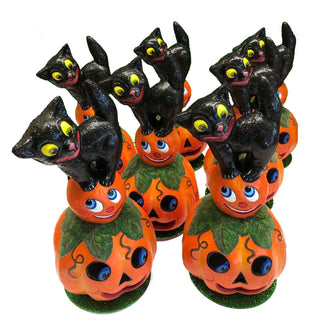Ino Schaller:
The Craftsmanship of German Paper Mache

 |
When the company's founder Carl Schaller laid the foundation for his family-owned company in 1894 with the production of filling figures of paper mache, he had no way of knowing that his company would still exist as many as 120 years later, selling the popular papier mache figurines around the world from Meilschnitz. |
|
In the 1950s, the paper mache figurines were displaced. Both Ino and his son Dieter Schaller focused on the new plastic figurines. The old paper mache technique would almost have been forgotten. However, the family kept the beautiful old moulds, and with them the knowledge of material and production. In the 1980s, Thomas Schaller rediscovered the good old figurines and was so fascinated by them that he started to produce paper mache figurines again with the help of his father Dieter Schaller. This branch is currently going through a renaissance. The figurines are more popular than ever among their collectors and lovers, not only in the USA. |
 |
Paper Mache – an Old Craft

 |
The production of paper mache figurines as filling figures for sweets started as early as in the 19th century and originates from the Neustadt/Sonneberg area. In the toy museum of Neustadt, the production method of the time is still presented: First, they used a mix of flour and glue. Later, in the 1920s, this procedure was refined. Since then, our paper mache figurines have been cast according to the old family recipe. Only few artisans today have mastered this production method. |
|
The process for producing a figurine takes approx. 7 days. In the beginning, a liquid mass of paper and glue and other ingredients is made. This is then cast in hand-made two-part moulds the next day. Superfluous water initially escapes into the porous mould. The next day, the slightly dried cast is carefully taken from the mould and slowly dried further in a room with controlled temperature. On the fourth day, the figurines are prepared for further processing. |
 |

|
| When the company's founder Carl Schaller laid the foundation for his family-owned company in 1894 with the production of filling figures of paper mache, he had no way of knowing that his company would still exist as many as 120 years later, selling the popular papier mache figurines around the world from Meilschnitz. The trained embosser from Neustadt modelled and produced the templates for his figurines himself before they were decorated and painted by his entire family – including the children. Carl's son Ino, a trained baker, took over the family company in the 1940s. He gave the manufacture Ino Schaller its name. |
 |
In the 1950s, the paper mache figurines were displaced. Both Ino and his son Dieter Schaller focused on the new plastic figurines. The old paper mache technique would almost have been forgotten. However, the family kept the beautiful old moulds, and with them the knowledge of material and production. In the 1980s, Thomas Schaller rediscovered the good old figurines and was so fascinated by them that he started to produce paper mache figurines again with the help of his father Dieter Schaller. This branch is currently going through a renaissance. The figurines are more popular than ever among their collectors and lovers, not only in the USA.  Even today, the family-owned company is structured to involve everyone in the production. The Manufaktur Ino Schaller remained in the family's hands at all times. Dieter and Ursula Schaller manage operations in the 3rd generation and are still involved with the business. Their children Thomas Schaller & Christina Franke-Schaller now continue the operation as representatives of the 4th generation. |
Paper Mache
An Old Craft
 |
| The production of paper mache figurines as filling figures for sweets started as early as in the 19th century and originates from the Neustadt/Sonneberg area. In the toy museum of Neustadt, the production method of the time is still presented: First, they used a mix of flour and glue. Later, in the 1920s, this procedure was refined. Since then, our paper mache figurines have been cast according to the old family recipe. Only few artisans today have mastered this production method. |
 |
| The process for producing a figurine takes approx. 7 days. In the beginning, a liquid mass of paper and glue and other ingredients is made. This is then cast in hand-made two-part moulds the next day. Superfluous water initially escapes into the porous mould. The next day, the slightly dried cast is carefully taken from the mould and slowly dried further in a room with controlled temperature. On the fourth day, the figurines are prepared for further processing. This way, the figurines can be artfully hand-painted and decorated with creative designs such as landscapes and patterns in the remaining days. Glitter, glass beads and fur provide attractive special effects. Thus, every figurine becomes one of a kind– hand-signed and with a certificate of authenticity. |
 |